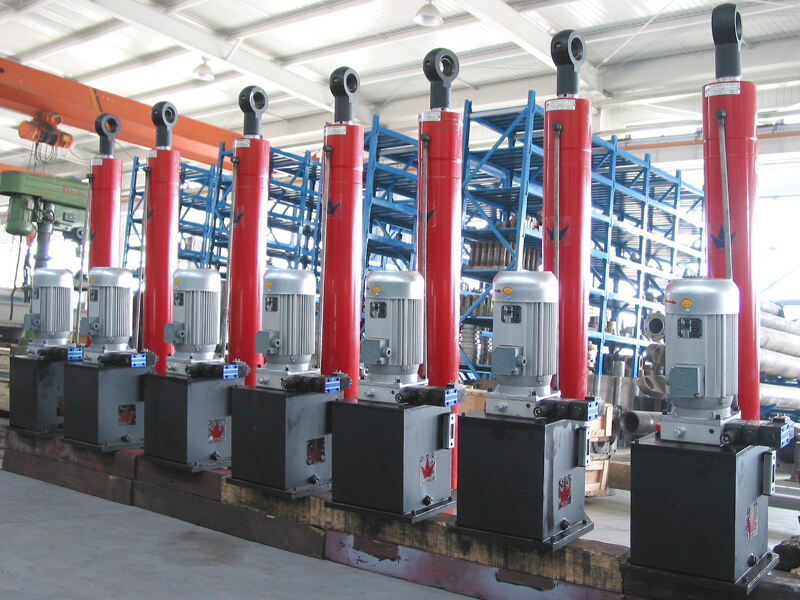Understanding Electric Power Jacks: Functionality and Hydraulic Integration
Key Components of Electric Power Jacks
Electric power jacks are vital tools in modern construction, featuring several essential components that work harmoniously to achieve efficient lifting. These include the motor, hydraulic cylinder, and control system. The motor, primarily electric, powers the hydraulic pump, which moves hydraulic fluid to the cylinder, producing the required lifting force. This interconnected mechanism is crucial for the seamless operation of electric power jacks, ensuring they meet the demands of various lifting tasks.
Additionally, integration of sensors such as overload protection sensors enhances the safety and performance of electric power jacks. These sensors ensure the equipment operates within its designated load capacity, preventing potential mishaps. By understanding the function and interactions of these components, users can better appreciate the sophistication and utility of electric power jacks in various construction contexts.
The Role of Hydraulic Systems in Electric Jacks
Hydraulic systems play a fundamental role in the functionality of electric power jacks, utilizing pressurized fluid to facilitate movement. This integration is vital for achieving the lifting capabilities necessary in construction and other heavy-duty tasks. With components such as hydraulic cylinders and power packs, these systems ensure smooth and powerful operations, allowing electric jacks to support substantial weights reliably.
Central to the effectiveness of hydraulic systems in electric jacks is an understanding of hydraulic principles like Pascal's Law. This principle explains how force is distributed uniformly through hydraulic fluids, a concept crucial for optimizing the use of electric jacks. By comprehending these underlying hydraulic principles, users can leverage the full potential and lifting capacity of electric power jacks, ensuring safe and efficient operations in various applications.
Dual-Function Capabilities in Construction Lifting
Lifting Heavy Loads with Precision
Electric power jacks are essential tools in the construction industry, offering unparalleled lifting capabilities for loads weighing several tons. These jacks provide reliable solutions for a wide range of construction projects, where precision and safety are paramount. The integration of electric systems ensures precise control, minimizing the risk of unexpected load shifts and potential accidents during lifting operations. Furthermore, dual-function jacks enhance operational efficiency by offering both lifting and lowering capabilities seamlessly. This dual-functionality not only reduces time but also contributes to the smooth flow of construction tasks.
The ability of electric power jacks to lift heavy loads with precision has transformed the approach to large-scale construction projects. By incorporating this technology, constructors can enhance safety measures while achieving efficient material handling. The focus on precision ensures that every lift is controlled accurately, mitigating risks associated with heavy-duty construction activities.
Stabilizing and Positioning Applications
Apart from their lifting capabilities, electric power jacks are increasingly being utilized for stabilizing structures during construction, highlighting their importance for safety. These jacks play a critical role in maintaining stability, which is paramount when undertaking complex construction tasks. Their positioning applications facilitate the accurate placement of heavy materials and equipment, essential for precision in construction operations.
Employing stabilizing jacks streamlines workflows, significantly reducing the time required to secure and position heavy loads. This efficiency translates into cost savings and the timely completion of construction projects. By enabling safe and precise positioning, electric power jacks ensure that construction work progresses smoothly and efficiently, contributing to the overall safety and success of the project.
Safety Standards and Operational Best Practices
ASME B30 Compliance for Hydraulic and Electric Jacks
Compliance with the ASME B30 standards is crucial for the safe operation and reliability of hydraulic and electric jacks used in lifting. These guidelines are specifically designed to ensure public safety by setting forth operational requirements that include thorough inspection protocols and limitations on load capacity. Adhering to these standards not only enhances the safety of lifting operations but also minimizes risks associated with the use of such equipment. Regular audits and adherence to ASME B30 regulations are essential practices that can prevent workplace accidents and foster a secure job site environment.
Implementing Safety Protocols on Site
Establishing comprehensive safety protocols before employing electric and hydraulic jacks is essential in mitigating risks during their operation. Operator training plays a pivotal role in ensuring that personnel are well-versed in both the functionality of the equipment and the emergency procedures required to prevent hazards. It is critical that operators wear appropriate safety gear, including helmets and harnesses, and utilize effective communication tools to enhance on-site safety. This emphasis on precautionary measures not only safeguards employees but also ensures seamless and efficient operation of hydraulic lift systems.
Applications and Maintenance in Construction Scenarios
Versatile Use Cases in Modern Construction
Electric power jacks demonstrate remarkable versatility in construction settings, addressing various tasks efficiently. These devices are instrumental in lifting materials, elevating construction equipment, and handling heavy loads. For instance, they are often used to install large girders, adjust scaffolding heights, and move hefty machinery into specific positions. This adaptability of electric jacks significantly enhances the effectiveness and efficiency of construction projects. By minimizing manual labor and maximizing precision, these jacks expedite project timelines and ensure high safety standards are maintained on-site.
Ensuring Longevity Through Proper Maintenance
To maintain the longevity and efficient operation of electric power jacks, regular maintenance is paramount. This involves essential checks such as monitoring hydraulic fluid levels and verifying motor functionality. Instituting a consistent maintenance schedule can help avoid premature wear and ensure continued adherence to safety standards. Key maintenance activities include the cleaning of filters, inspecting seals to prevent leaks, and scrutinizing the electrical circuit systems for faults. Such maintenance practices not only extend the life of the jacks but also guarantee their reliability and operational readiness when needed.


